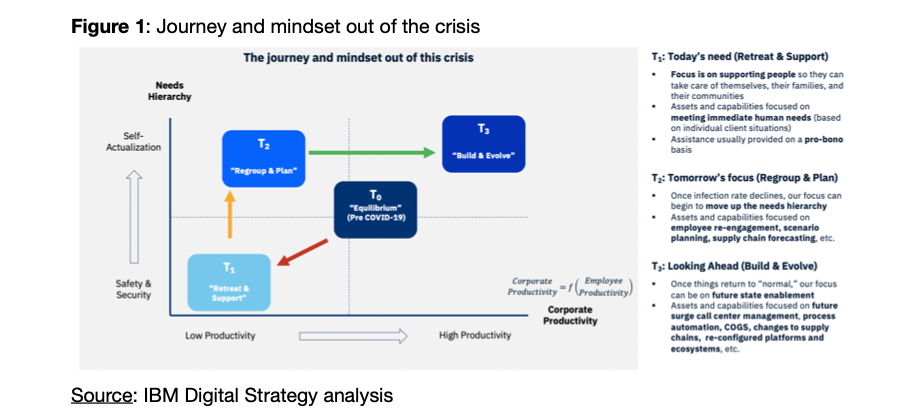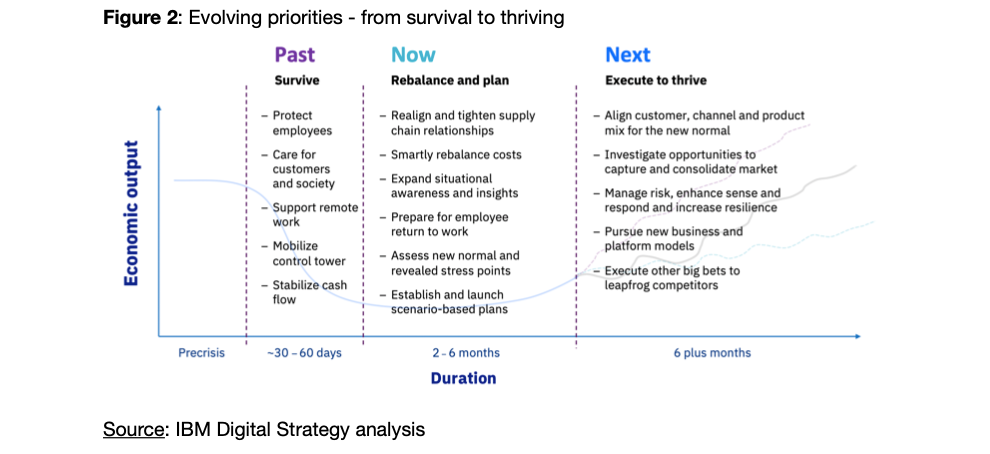Using A ‘Human-First’ Approach To Developing The ‘New- Normal’ As We Recover From Today’s Crisis
By Janahan Tharmaratnam, Digital Strategy Leader, IBM MEA

The ‘new normal’ is a very commonly used term these days. It has been as frequent and overly used as Digital, Disruption and Artificial Intelligence.
However, what does it mean and why is it important?
The emergence of COVID-19 has led to unprecedented change and challenges for corporations and governments globally. Corporations today operate in a balance between meeting employee needs and maximizing economic profit.
Prior to COVID-19, corporations were at an equilibrium, “T0,” which has been disrupted by the emergence of COVID-19. This new, unprecedented crisis “T1” has created unique challenges:
- Today’s workforce is focused on safety, security, and self-preservation.
- Corporations & Governments need to rethink how they communicate, motivate, and enable their employees.
- There is a large economic cost to this crisis, but an even larger human cost.
The way out of today’s crisis may lie within a “human-first” approach, aligning actions with the changing mindset.

New Normal – What does it mean?
IBM’s view is that the ‘new normal’ should be about developing meaningful and lasting changes in the business environment that create opportunity for those able to anticipate and capitalize on them. It will drive structural changes in how successfully companies and governments will organize and operate to thrive in that environment.
Why is it important?
Looking through the crisis, the ‘new normal’:
- Presents a number of new opportunities created or acceleration of digital / transformation agendas (e.g., new business and platform models, customer segments, products/services, channels).
- It introduces the potential for new types of competitive threats.
- Defines a new business baseline against which to budget and plan
- Guides the path to ensure resilience and flexibility in future shocks and uncertainty
Based on a number of CEO, CFO and CIO polls that IBM have recently conducted globally, many companies are beginning to plan for the new normal.

What are the characteristics of the new normal?
Let’s look at it from two different lenses: outside-in (what are the changes to the business environment in which we operate) and inside-out (how does the operations and structure of an organization have to change).
Outside-in:
- Demand shift – A forecasted dip in sectors such as tourism, travel and mass transportation, but increases in sectors such as telemedicine, healthcare equipment and telecommunication.
- Massive shift to online – everyone will have to have a powerful ‘digital front door’ as most transactions move online through powerful industry-led marketplace platforms.
- New business models – The gig-economy goes into over-drive through adopting flexible outsourcing and as-a-service models.
- New competitor landscape – Through market consolidation and substantive M&A activity planned in the next 6 to 24 months, the classic Porters 5-forces model (competitors, new market entrants, suppliers, customers and substitutes) will be very different in 2021.
- Expanded role of government – Big government is ‘in’ now with massive bail-outs, funding packages and grandfathering of contracts. What is the ‘pound of flesh’? Everyone has to pay – including those who have weathered the crisis well.
Inside-out:
- Era of resilience and agility: Depending less on external supply chains and more vertical integration. This would be like moving from a General Motors global supply chain model to a Tesla ‘made in California’ model.
- Business intelligence imperative: The terms control tower and nerve-center have been used quite often in the public press, and in-essence the need is to use more real-time information to enable decision making. Gone are the days of annual and quarterly business planning.
- Cost flexibility: Expanding the outsourcing relationships and the business ecosystem to be able to reduce and variablize costs: i.e. balance operational expenditure with capital expenditure through business cycles.
- Securing unleashed digital, data and technology: Much more adoption of exponential technologies to enable initiatives such as self-service and warehouse automation.
-
New ways of working: How will remote work and globally distributed teams work more effectively? How does virtual become reality?
Way forward
In the Digital & Technology space, we often refer to a 2-speed enterprise where longer term programs (that deliver benefits at scale) alongside short term quick-wins (that deliver incremental benefit). The new normal would need a 3-speed enterprise which (unfortunately) operate in potential conflict with each other.
-
Cost transformation: Develop new revenue baselines and identify ‘value pools’ where near term effort can be focused on providing revenue to keep the business afloat – what are your hidden gems?
-
Define the growth agenda: Who are your new customers and what platforms / business models will be required to engage with them?
-
Apply flexibility and resilience: Operationally, how can you keep the lights-on whilst in an environment where your external ecosystem will have challenges and when the next pandemic occurs (which is highly likely going forward) how do we avoid such crisis-oriented behavior?
‘However implemented, organisations and governments need to keep in mind that digital transformation is all about being laser focused on the customer and employee experience in equal measures.’
-





